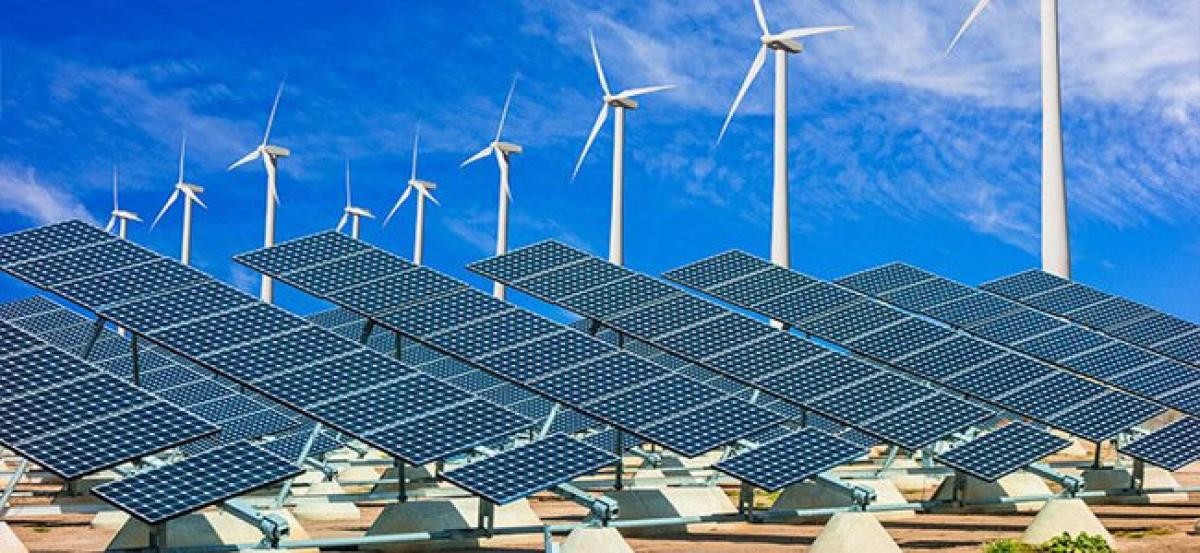Live
- Namma Metro: 21 New Trains To Be Added By Next Year
- Gold rates in Vijayawada today slashes, check the rates on 28 November, 2024
- De-silting of Bhadrakali Lake begins
- Street vendors asked to utilise SVANidhi scheme
- AP govt. to distribute elderly pensions a day before amid holiday
- Lingayat Panchamasali community to stage protest on Dec 10
- Mangaluru resident falls prey to APK scam, loses lakhs
- Mysugar factory throws farmers into distress
- Gold rates in Hyderabad today slashes, check the rates on 28 November, 2024
- Deteriorating living conditions in Kuduramukha: Daily wage workers deprived of basic amenities
Just In

As the solar power tariffs in India have plunged to low of Rs 3 per unit, there is some uncertainty over the solar parks that are under construction and were completed recently in Andhra Pradesh for which high tariffs have been fixed.
Amaravati: As the solar power tariffs in India have plunged to low of Rs 3 per unit, there is some uncertainty over the solar parks that are under construction and were completed recently in Andhra Pradesh for which high tariffs have been fixed.
1. Tariff fixed between Rs 3.50 to Rs 4.50 in AP while it is Rs 2.40 to Rs 2.60 in other states
2. States fix low power tariffs to attract industries
While the AP government is in a hurry to complete some solar parks for which the tariff has been fixed between Rs 3. 50 to Rs 4.50, the Gujarat government cancelled 500 MW solar auction results a few days ago for which tariff was quoted at Rs 2.98 as it felt the tariff quoted by bidders to supply power was high. Some other states, like Rajastan, fixed tariff at Rs 2.34. The state governments think that the low tariff attracts investors to set up industries. A senior official of AP Solar Power Corporation said that utter confusion prevailed in solar industry due to fluctuations in power supply tariffs and said he could not comment over the prevailing conditions in solar power sector of AP due to reduction in tariffs.
The AP government, which wants to be in the forefront among the all other states in the country, has targeted to set up solar parks to generate 4,000 MW by 2020. A 750 MW solar park in Anantapur by NTPC, 500 MW park in Galiveedu, 1,000 MW park in Kadapa and 500 MW solar park in Ananthapur by APGenco are under process in the state. The 1,000 MW largest solar park in Kurnool and 250 MW park in Anantapur have already been commissioned. According to sources, the state government allowed Solar Power Corporation of India Ltd (SECI) to fix tariff at Rs 4.50 per unit under VGF scheme for 500 MW solar parks in Galiveedu. The tariff was fixed at Rs 3.57 aunit for 400 MW solar park in Kadapa and Rs 3.15 for 250 MW in Kadapa. Works are in progress for some solar parks and some other are at tenders stage.
When contacted, managing director of AP Solar Power Corporation Ltd G Adisheshu said the tariffs fixed for the above mentioned projects was considered as reasonable then. “The tariffs for solar parks in Galiveedu and other places were fixed one-and half year ago. But the tariffs plunged to low after some time. We can do nothing in this connection as agreements were signed with bidders and works also commissioned for some solar parks,” he said. In fact, the tariff for solar power plunged to Rs 2.44/ unit in 2017. The Gujarat Urja Vikas Nigam Ltd held auction in September 2017 in which the tariffs quoted between Rs 2.67 and Rs 2.69/unit. Due to this, the GUVNL cancelled the auction which was held in March 28 this year in which the tariffs were quoted between Rs 2.98 and Rs 3.06.
As the thermal power is available at a rate of slightly above Rs 4 a unit, several states consider that the tariff for sloar power is not viable if it is more than Rs 3. Adisheshu said the state government decided to fix tariff at Rs 3 for Solar projects in Ananthapuram and Kadapa in the wake of fluctuations in tariffs for sloar power. A senior official of AP Solar Corporation said, “It may difficult to compete with other states due to high tariff in the state. But, we have no option now other than offset the existing solar projects for which a high tariff is fixed, with the future projects by fixing low tariff to them.”
BY K Varaprasada Rao

© 2024 Hyderabad Media House Limited/The Hans India. All rights reserved. Powered by hocalwire.com







